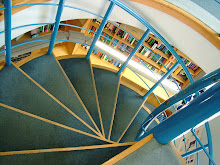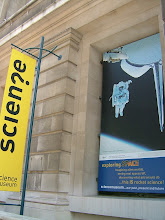Phys. Rev. Lett. 61, 169 (issue of 11 July 1988) Phys. Rev. Lett. 48, 596 (issue of 1 March 1982) Phys. Rev. Lett. 40, 1639 (issue of 19 June 1978) Titles and Authors
2 April 2008
Landmarks: Laser Cooling of Atoms
H. M. Helfer/NIST
Frozen. A cloud of cold sodium atoms (bright spot at center) floats in a trap. Researchers began cooling atoms with lasers in 1978, reaching below 40 Kelvin. They achieved temperatures a million times colder just ten years later, eventually leading to better atomic clocks and the observation of a new ultracold state of matter.
APS has put the entire Physical Review archive online, back to 1893. Focus Landmarks feature important papers from the archive.
In the 1970s and 80s, physicists learned how to use lasers to cool atoms to temperatures just barely above absolute zero. Three papers from that era, all published in Physical Review Letters, highlight some of the essential steps in the development of the technology. In 1978, researchers cooled ions somewhat below 40 Kelvin; ten years later, neutral atoms had gotten a million times colder, to 43 microkelvin. But the basic principle remained the same: use the force of laser light applied to atoms to slow them down. The work led to the creation of a new quantum form of matter called a Bose-Einstein condensate and to modern atomic clocks, as well as at least two Nobel prizes.
The original reason to cool atoms--that is, reduce the speed of their motion--was to allow more precise measurements of atomic spectra, and later, to improve atomic clocks. In 1978 Dave Wineland and his colleagues at what is now the National Institute of Standards and Technology (NIST) in Boulder, Colorado, followed theoretical proposals [1] and managed to laser cool magnesium ions.
As the team described in PRL, they confined the ions in an electromagnetic trap and hit them with a laser tuned to a frequency a bit below a "resonance" frequency for the ions. At rest, the ions absorb photons at the resonance frequency, but if they're moving toward the beam, its lower frequency appears Doppler shifted to the correct frequency, allowing them to absorb photons coming toward them. These photons slow down the ions until the cooling effect is balanced by the small heating that is always present when the laser is on. In later years, this heating--which comes from atoms recoiling every time they randomly emit or absorb a photon in any direction--would ultimately limit the cooling possible with this so-called Doppler cooling technique.
In Boston, William Phillips read Wineland's experimental article and a theoretical paper [2] with great interest. He was just finishing a postdoctoral fellowship at the Massachusetts Institute of Technology and heading to the NIST lab in Gaithersburg, Maryland. "The idea of cooling ions made me think that it might be possible to do the same thing with neutral atoms," says Phillips.
In 1982, Phillips and Harold Metcalf of Stony Brook University in New York published the first paper on laser cooling of neutral atoms. They sent a beam of sodium atoms through a magnetic field that was large at the entrance to the apparatus but became gradually smaller over a distance of 60 centimeters. While moving through the field, the atoms headed directly into an off-resonance laser that used Doppler cooling to reduce the range of atomic velocities among atoms in the beam. The laser also slowed the beam as a whole. During deceleration, the changing magnetic field changed the atoms' resonant frequency, so that the slowing and cooling continued over a long distance, allowing them to reach 40 percent of their initial velocity. Now called a Zeeman slower, this device has become a standard way of decelerating an atomic beam.
Laser cooling techniques improved, and by the late 1980s, researchers had achieved what they thought were the lowest possible temperatures, according to Doppler cooling theory--240 microkelvin for sodium atoms. Then in 1988, a group led by Phillips accidentally discovered that a technique developed three years earlier at another lab [3] could shatter the Doppler limit. They used three mutually perpendicular pairs of lasers to cool sodium atoms, with laser frequencies somewhat different from other labs. They discovered, using several new temperature measurement techniques, that their atoms were at about 43 microkelvin. Theorists quickly explained the unexpected cooling mechanisms by including more atomic states and the effects of laser polarization; previous cooling models were overly simplistic.
Guided by the new theory, experimentalists reached much colder temperatures and developed additional cooling techniques. Phillips' "sub-Doppler" cooling was an early step in the 1995 creation of a Bose-Einstein condensate, a new state of matter where gaseous atoms all drop to the lowest possible energy state.
Atomic clocks benefited as well. The latest generation uses techniques derived directly from what Phillips and others did in the 1980s. Phillips and others won the Nobel Prize in 1997 for developing laser cooling; another prize in 2001 was awarded for the creation of Bose-Einstein condensates.--Jason Socrates Bardi Jason Socrates Bardi is a senior science writer at the American Institute of Physics.
References:[1] D. J. Wineland and H. Dehmelt, Bull. Am. Phys. Soc. 20, 637 (1975); T. W. Hänsch and A. L. Schawlow, "Cooling of Gases by Laser Radiation," Opt. Commun. 13, 68 (1975).[2] A. Ashkin, "Trapping of Atoms by Resonance Radiation Pressure," Phys. Rev. Lett. 40, 729 (1978).[3] S. Chu et al., "Three-Dimensional Viscous Confinement and Cooling of Atoms by Resonance Radiation Pressure," Phys. Rev. Lett. 55, 48 (1985).
Related Information:
1997 Nobel Prize in physics
Observation of Atoms Laser Cooled below the Doppler Limit Paul D. Lett, Richard N. Watts, Christoph I. Westbrook, William D. Phillips, Phillip L. Gould, and Harold J. Metcalf Phys. Rev. Lett. 61, 169 (issue of 11 July 1988)
Laser Deceleration of an Atomic Beam William D. Phillips and Harold Metcalf Phys. Rev. Lett. 48, 596 (issue of 1 March 1982)
Radiation-Pressure Cooling of Bound Resonant Absorbers D. J. Wineland, R. E. Drullinger, and F. L. Walls Phys. Rev. Lett. 40, 1639 (issue of 19 June 1978)
From : http://focus.aps.org/story/v21/st11
skip to main |
skip to sidebar


Cambridge University Press

Books






站在巨人的肩膀上 追尋著愛奧尼亞式迷情的源頭 找尋著存在的意義 心靈最深層的印記 烙印著傳承的使命 隨著宇宙萬物幻化 開啟不朽之殿堂

網誌存檔
Cambridge University Press

Cambridge University Press
Books

Books
Physics

British Musuem

Greenwich Observer

Science Museum

Adventurer

2008

沒有留言:
張貼留言